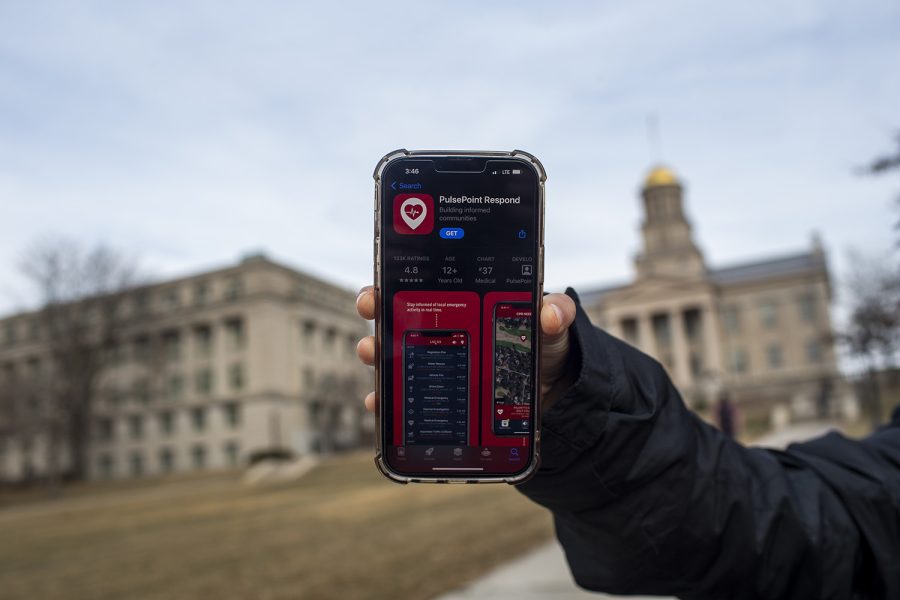App to alert Johnson County citizens of nearby cardiac arrests
Johnson County recently adopted the PulsePoint app to assist its ambulance service. The free mobile app notifies CPR-trained citizens of cardiac events happening in their vicinity.
A photo of the PulsePoint Respond app taken on Monday, Feb. 21, 2022 in front of the Old Capitol building.
February 24, 2022
The Johnson County Ambulance Service is adopting an app that notifies CPR-trained citizens to assist with cardiac arrests happening nearby.
PulsePoint Respond is a free mobile app that allows citizens to provide potentially life‐saving aid to victims of sudden cardiac arrest and updates users of emergency activity in real-time.
If reported to a 911 dispatcher that an individual is experiencing a cardiac arrest in a public location, the dispatcher alerts PulsePoint users, who are within one to 2,000 feet of the victim while EMS dispatch is en route.
PulsePoint is connected to 4,234 communities in North America, and has 743,921 active users on the platform, according to its website.
The Johnson County Ambulance Service responds to 79 cardiac arrests every year.
Johnson County started using PulsePoint on Feb. 14 and is the second PulsePoint community in Iowa, with West Des Moines being the first to enact the system, Fiona Johnson, director of the Johnson County Ambulance Service, said.
Johnson said residents that have PulsePoint help emergency responders in performing the first three links of surviving a cardiac arrest, which is calling 911, starting CPR, and accessing an automated external defibrillator, or AED, if possible.
“We need the help in order to improve survival because it doesn’t matter how fast ambulances is, or how skilled the staff on the ambulance are, if we don’t have bystanders assisting with CPR or AED use before we get there, we won’t be able to see improvement in our survival statistics,” Johnson said.
The Johnson County Ambulance Service partnered with the Iowa City Rotary Club’s Rotary-Kerber HeartSafe Community Campaign to bring PulsePoint to the county.
Dianne Atkins, University of Iowa professor emerita of pediatric cardiology and medical director of the campaign, said that for every minute that goes by without CPR, the chance for surviving a cardiac arrest declines by 10 percent.
“With Pulse Point, CPR can start earlier before EMS gets there, and we know from data that this really improves survival from cardiac arrest, as well as meaningful survival, meaning that you have minimal neurologic complications after recovery,” Atkins said.
The Rotary-Kerber HeartSafe Community Campaign was established to honor Richard Kerber, a faculty member at the UI Health Care’s Division of Cardiology for more than 45 years.
Some of the goals of the campaign are to provide AEDs to nonprofits and communities, as well as to promote, teach, and provide free CPR training to those interested.
The app is also accompanied by PulsePoint AED, a companion tool that informs users where the closest AEDs are located and lets users update the app on where other AEDs may be located.
Johnson said that there are currently 284 AEDs located around Johnson County, with a vast majority of them located in the Iowa City and Coralville area.
Richard Kerber’s wife, Linda Kerber, the UI May Brodbeck professor emerita in the college of liberal arts and sciences and of history, said she knows her husband would be pleased because of his work on increasing public knowledge on cardiovascular information.
“It makes me smile just to think about how more people will be aware of what they can do and they’ll be proactive,” Kerber said.
Atkins said the county’s implementation of PulsePoint is a step in the right direction towards a higher survival rate for citizens.
“We’re very fortunate in Johnson County to have a highly organized and well-trained ambulance service but they can’t always get there in time,” she said. “The most important part of survival from a cardiac arrest is early CPR and early defibrillation, and this gives us a chance to optimize and maximize our cardiac arrest survival.”



